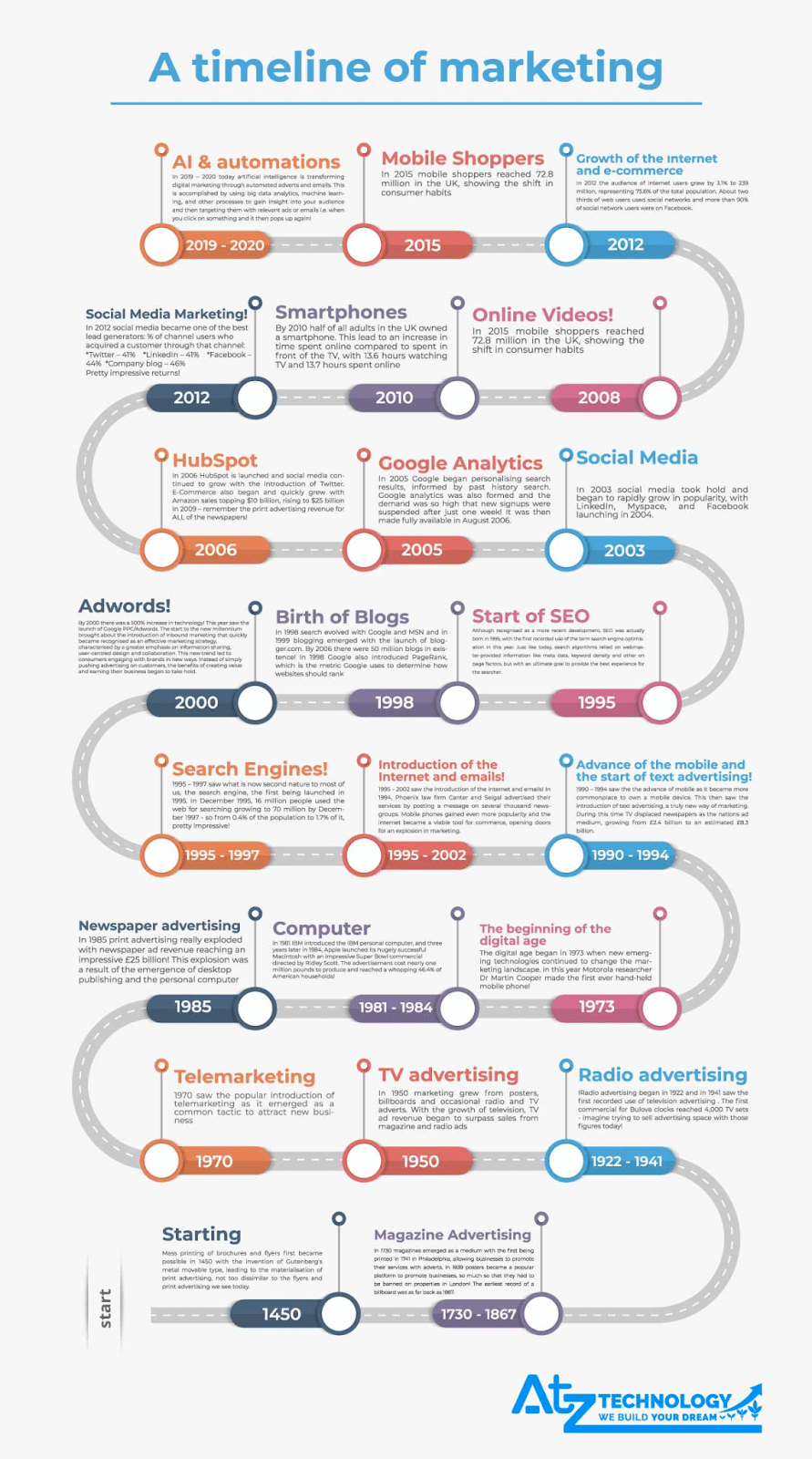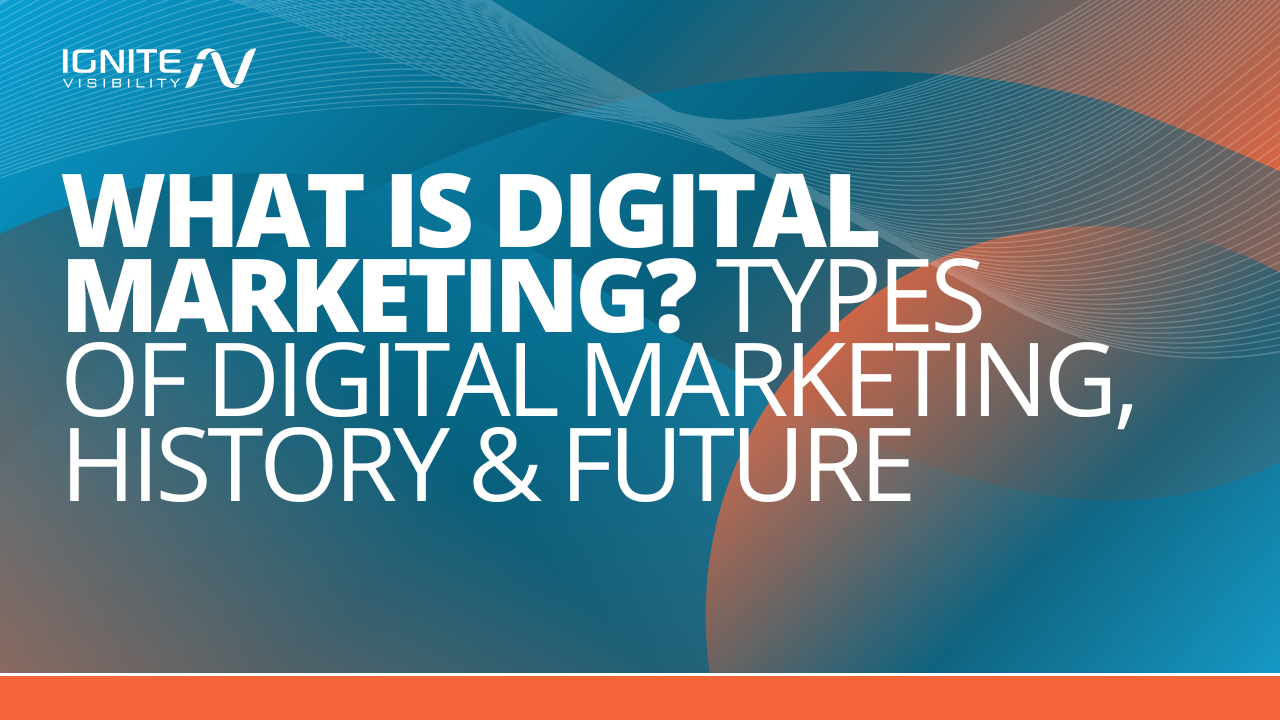
Digital marketing has evolved rapidly since the first website was created in 1991. The internet now connects people and brands from all across the world with a simple click of a mouse or a tap on a smartphone.
While digital marketing may seem like just a part of our daily lives now, it hasn’t always been that way. Learning about the history of digital marketing can help you understand how to make it work for your business successfully.
Are you ready to tap into the incredible resource that is the internet? Let’s talk more about the evolution of digital marketing and how it can help you build a business empire.
What You’ll Learn:
- What is Digital Marketing?
- What Are the Benefits of Digital Marketing?
- A Historical Overview: How to Explain Digital Marketing
- Who Invented Digital Marketing?
- Core Components of Digital Marketing
- Evolution of Digital Marketing
- Data and Privacy Compliance Updates
- Milestone Moments in Digital Marketing
- The Future of Digital Marketing
- What is Digital Marketing? FAQs
What is Digital Marketing?
Before exploring the different types of digital marketing, what is the definition of digital marketing, exactly?
Digital marketing includes all of your business’s marketing activities through digital channels like social media, blogs, websites, email, and search engine optimization.
Today’s definition of digital marketing encompasses even more, including AI-driven automation, generative AI content, and voice search optimization, among other digital marketing technologies.
Some of the more specific emerging digital marketing technologies include:
- The Metaverse: With the development of the Metaverse and the blending of physical and digital worlds, marketers can take advantage of immersive technologies to market products and brands in creative, interactive ways.
- AR/VR: In line with the Metaverse is the development of augmented reality (AR) and virtual reality (VR) technologies. For example, AR can enable people to see virtual objects at scale in real-world environments to test them, while VR allows people to explore detailed virtual spaces, such as showrooms.
- Blockchain Marketing: This strategy uses blockchain technology to optimize security and transparency, which can subsequently build more trust among audiences.
- Predictive Analytics: Using existing data and AI, marketers can determine which strategies will
While digital marketing’s goals and objectives change depending on the business, it often aims to reach new audiences, enhance brand awareness, and generate new leads. There are many different digital marketing types, but when used correctly, they can deliver a high return on investment.
What Are the Benefits of Digital Marketing?
Key advantages of digital marketing include:
- Broad reach, allowing engagement with audiences globally at any time
- Customize marketing strategies to deliver what the customer wants, not simply what they might be interested in
- Modify your campaign as you go, adapting to drive the best possible results
- Cost-efficient and offers a higher return on investment
- Provides measurable results, giving you valuable insights to make informed decisions
To really understand where digital marketing is today, let’s take a look at where it all started.
A Historical Overview: How to Explain Digital Marketing
While it’s easy to remember a time before digital marketing, it’s hard to picture a world without it now. Consider the history of digital marketing and the different forms of digital marketing through the years.
1990s
The 1990s included the birth of banner ads. These ads would appear at the top of websites and blogs, showcasing various businesses. Banner ads were successful then, and they’re successful now for one reason: because they work.
As the internet became a more integral part of society and more people acquired computers in their homes, blogs began to gain popularity. With blogs came more opportunities for digital marketing. This started to usher in the birth of SEO and Adwords.
2000s
Even though Google was launched in 1998, it really started to pick up steam in the early 2000s. Yahoo, MSN Search (now Bing), and Ask Jeeves were also popular in the early to mid-2000s.
The 2000s also brought us something else – social media. MySpace launched the social media craze in 2003, with Facebook following closely behind in 2004. When people weren’t picking out their profile song or rearranging their Top 8 on MySpace, they were being served banner ads and other forms of digital marketing.
YouTube was launched shortly after in 2005, followed by Twitter, Pinterest, and LinkedIn.
2010s
Now that digital marketing was in full swing, the 2010s introduced us to influencers. With the rise of smartphones and tablets, building an influencer network started to take over digital marketing. Consumers wanted to hear what everyday, normal people were interested in.
When Instagram hit the scene in 2011, it was time for influencers to shine. The picture-focused app provided users with the opportunity to discover things they liked and follow people they didn’t know. Consumers started to fall in love with influencer marketing, and the history of digital marketing took a turn.
It wasn’t just everyday people who jumped into influencer marketing; it was celebrities, too. Instagram hit one million users in its first three months, including household names such as Ariana Grande, Beyoncé, Kim Kardashian, and Justin Bieber. It was totally new (and more personal!) way for brands to reach consumers.
2020s
Once the COVID-19 pandemic hit in early 2020, consumers started to embrace short-form video content. Platforms like TikTok, Instagram Reels, and YouTube Shorts became a cornerstone of digital marketing.
With the evolution of digital marketing, the use of artificial intelligence (AI) has also undergone significant changes. Now, digital marketers are utilizing AI tools to assist in creating content, gathering data, and optimizing personalization in their ad campaigns. This has prompted concerns around user privacy and the ethical implications of AI usage.
Whether for good or bad, digital marketing has undoubtedly transformed our societies and the marketing world. So, who should we thank for starting us on this path of evolution?
Who Invented Digital Marketing?
As it turns out, there’s no one single inventor of digital marketing. It’s not about one singular person who invented it. It’s about the movement that followed.
We can trace this groundbreaking form of consumer engagement all the way back to the late 1800s when Guglielmo Marconi invented the radio. And there’s no denying that it has evolved since then.
Digital marketing was reborn in 1971 when Ray Tomlinson sent the first-ever email. This led Philip Kotler, an American professor, to write more than 60 marketing books, including those on digital marketing philosophy and strategic theory.
The first banner ad popped up in 1994, when AT&T paid $30,000 for HotWired to place an ad on their website for 3 months.

Regardless of how it started or who wrote the most extensive digital marketing overview, the truth is that once the various types of digital marketing burst onto the scene, they changed the way retailers and consumers interact with each other forever.
Core Components of Digital Marketing
Digital marketing is diverse, offering various approaches. Without proper research and planning, there’s a risk of missing optimal strategies for your brand. The types of digital marketing used by companies will depend primarily on each brand’s unique needs and the audiences they’re targeting.
Here are the top 9 different types of digital marketing to consider for a successful strategy:
1. Search Engine Marketing (SEM)
SEM, or search engine marketing, is a highly effective marketing method in the B2B space. It focuses on optimizing brand presence and conversions through both paid and organic strategies.
Digital marketing includes different ways to get a search engine to pay attention to your brand, including organic and paid attempts. Generally, however, when people discuss SEM, they are usually referring to paid advertisements, such as Google Ads.
But there’s no denying that the difference between paid and organic search results is pretty interesting. Research shows that a top organic result has an almost 40% click-through rate, while the top paid result only has a CTR of 2%. That’s a huge difference in traffic! Almost 20x more!
That doesn’t mean to rule out paid options. According to Statista, almost 40% of all ad spending comes from these search advertisements, so they must be working!
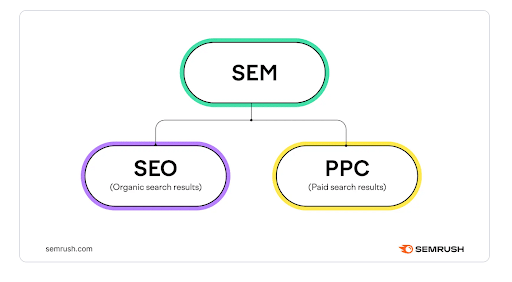
2. Search Engine Optimization (SEO)
SEO, or search engine optimization, is a cornerstone of most business’s digital marketing campaigns.
SEO is the art of optimizing your content to ensure that your website is featured as a top result when relevant keywords are searched.
With most online businesses operating at the mercy of Google and other major search engines, ensuring your content appeases both your users and the search engines is imperative.
SEO is how you get your content to rank in those coveted top SERP spots. Never underestimate how much traffic you can get from well-positioned organic search results.
In fact, according to Search Engine Land, 53% of all website traffic is generated from those organic searches.
It’s Not All About Keywords
When it comes to SEO, it’s not just all about your keywords. From technical SEO to on-site and off-site SEO, there are many ways that you can put the work in to boost your ranking.
A big part of SEO is your content. Quality, well-written, and beneficial content will always win over sloppy, inaccurate content – both for your reader and for the search engine crawlers.
Algorithms change, but people don’t. So, it’s also important to remember to build your site for your user, not for the SEO algorithm.
People-First Content
Speaking to that last point, the latest updates in the digital marketing fundamentals of SEO have to do with people-first content. More recent Google updates—like the Helpful Content Update, the development of E-E-A-T guidelines, and AI-generated content policies—prioritize content that helps users rather than trying to game the algorithm.
Of course, search engine user behavior is also changing largely due to generative AI. With the introduction of AI-driven SERP features like AI Overviews and AI Mode, people can find everything they need without ever leaving search engine results. At the same time, the queries they enter are often much more conversational than traditional searches, and these platforms cite sources that appeal to those queries.
Ultimately, your big focus should be on appealing to Google’s Core Web Vitals, mobile optimization for smartphone and tablet users, structured data to help search engine bots understand your website, and creating people-centric content.
And don’t forget about those images! Conduct an audit of your website’s images. Ensure they are compressed for faster loading times, include descriptive alt text, and have meaningful filenames. By taking these steps, you’ll improve user experience and enhance your SEO efforts simultaneously.

3. Content Marketing
We can’t explain digital marketing without heavily discussing content marketing, too.
One of the broader terms you’ll probably encounter, content marketing covers content assets like blog posts, infographics, e-books, videos, white papers, and webinars. Its ultimate goal is to persuade your audience and build credibility.

However, it’s not just something for your audience to read. According to Allied Market Research’s 2024 report shows that it is also a thriving industry, expected to reach $2 TRILLION by 2032.
That’s a pretty huge industry and one you should jump into now if you haven’t already. Content marketing has the potential to propel your brand into levels you’ve never seen before.
4. Paid Media
Pay-per-click (PPC) ads on search engine results pages fall under the SEM umbrella, but they can also extend to affiliate marketing and ads on other websites.
And what is PPC in digital marketing? An important piece of the puzzle! You’ll find PPC marketing scattered throughout your online experience – on social media sites, and on Google and Bing, among other places. You can notice them by the little “sponsored” label around it.

While Google Ads has a market share of 69%, making it the industry’s largest platform, PPC ads are also highly popular on other platforms, including Facebook, Amazon, TikTok, and Microsoft.

There are also many types of ad formats to use today, with the ability to use AI-driven ad personalization, video ads, and dynamic search ads that deliver tailored messaging and visuals based on each target audience segment.
With PPC ads, you only pay for the number of clicks that you receive on your ad, making it an attractive option for businesses that have tighter budget constraints.
Another development in PPC worth considering is Performance Max (PMax) campaigns, which help automate Google Ads to optimize performance across all Google and Google Partner platforms.
Meghan Parsons, Vice President of Paid Media, says, “The success lies in optimizing campaigns for platforms with the highest reported ROI rates, such as Facebook Ads and Google Ads.”
5. Email Marketing
Despite being one of the oldest types of digital marketing, email marketing is still one of the most reliable. In fact, over the last 12 months, 77% of marketers report having seen an increase in email marketing engagement.
It reached $8.3 billion in revenue by the end of 2023 and is expected to continue growing – up to $37.5 billion by the end of 2032!

Plus, the possibilities of the types of emails you can send are limitless. Choose from newsletter campaigns, confirmation emails, thank-you emails, follow-up emails, and email notifications about product updates.
AI is also making its way into all aspects of email marketing for optimized campaigns. One successful digital marketing campaign example using AI-driven email campaigns is SwiftShop, an online retailer that leveraged digital marketing technologies like predictive analytics, personalization, and segmentation to connect with email recipients.
Interactivity is another significant consideration, as you can incorporate surveys, videos, and gamification into emails to increase open rates. The more engaging your emails, the better they’ll perform and likely convert.
6. Social Media Marketing (SMM)
Without a doubt, social media has become one of the most popular types of digital marketing over the last decade. Its popularity has grown so much that most brands cannot offer to overlook adding it to their marketing strategy.
You might wonder, “What are digital channels worth using for social media marketing?” Thankfully, you can choose from various social media platforms, including Facebook, TikTok, LinkedIn, Instagram, X (formerly Twitter), Threads, Discord, BeReal, and many others. Depending on your niche and target audience, you can choose whichever one(s) is most relevant to your business.

When it comes to social media, there truly is something for everyone. The key to success here is finding where your target audience is hanging out.
While some brands considered social media as a necessary line of communication for B2C audiences, that has changed. Social media, known for its real-time connection and vast user base, has emerged as a critical marketing avenue for B2B interactions.
A recent study shows that 84% of B2B marketers are turning to social media, specifically LinkedIn, making it the most commonly used B2B marketing tactic. It is bringing about a paradigm shift in how businesses converse, engage, and ultimately forge enduring relationships.
Keep in mind that there are changes in the way people engage with social media as these platforms evolve. For example, algorithms now favor short-form video as people seek bite-sized content on everything from Facebook Reels to YouTube Shorts.
People also enjoy interactive content and creator collaborations that get them more involved on their favorite platforms and with their favorite personalities.
Of course, AI is also becoming increasingly integral to the social media experience, with AI-driven chatbots, content scheduling, and trend prediction available to help boost performance.
7. Digital PR
Another form of digital marketing is digital PR. Similar to traditional PR, digital PR involves using online platforms and channels to create a brand reputation that you can be proud of.
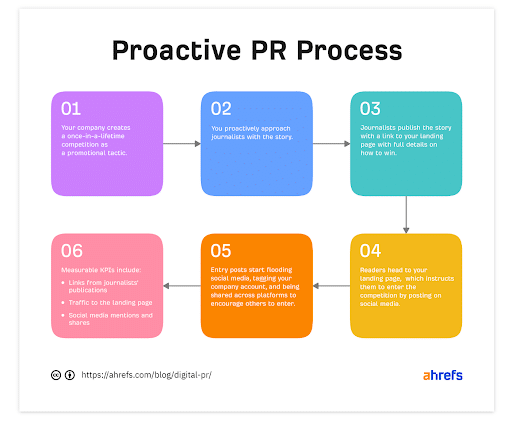
As Morgan Dixon, our VP of Digital PR, says, “If you’re going to be online, you need to invest in a solid digital PR strategy. Your audience is online, and they’re going to see what people are saying about you and how you respond to it and use that to determine whether or not to trust your brand. And when it comes to making a purchase, trust between brand and consumer is key.”
Improving your digital PR strategy will take some work through various components like media outreach, press releases, linkable assets, online reputation management, and more. Regardless of how much work you put into this, it’s still one of the most powerful digital marketing types.
8. Conversion Rate Optimization
Pushing traffic to your site is great, but it’s only half of the battle. Now that you’ve attracted their attention, how are you going to convert them? That’s where conversion rate optimization, or CRO, comes in.

CRO has three unique aspects: acquisition, activation, and retention. When developing your strategy, you have to look at ways to attract your audience but also to activate and retain them. For this to happen, you have to dive deep into your audience data.
CRO, in its simplest form, is the art (and science) of optimizing your website visitors to perform a desired action. But holistically speaking, it’s so much more than that. CRO is about understanding your audience, tweaking your website, and continually testing to provide users with the best experience possible.
9. Creative Marketing
You can’t define digital marketing without talking about creative marketing. To achieve true success in digital marketing, you have to create design elements that are creative, attractive, and cohesive.
What you post on social media should have the same general qualities as the content on your website and print ads. A cohesive and constant brand is key to generating brand awareness and turning all of your digital marketing attempts into brand loyalty and sales.
This goes far beyond a simple graphic. You have to think outside of the box. Many brands are finding success in designing creative video content.
Other brands are optimizing for voice searches done through tools like Amazon’s Alexa or iOS’s Siri. Others are still embracing influencer marketing, even getting more granular with smaller, nano-influencers. AI personalization tools are also seeing a rise in use among digital marketers who want to be ahead of their competition.
As Oscar Lutteroth, our Chief Creative Officer, says, “With the rise of mobile internet usage and social media platforms favoring video content, neglecting video content is no longer an option for brands looking to thrive. Video marketing isn’t just about keeping up with trends; it’s about leveraging a powerful storytelling tool that can significantly amplify brand presence, enhance user engagement, and drive real business results.”
The Evolution of Digital Marketing
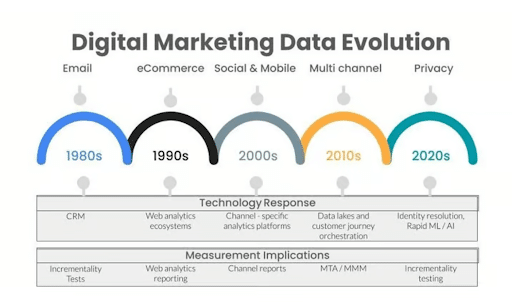
Looking at the history of digital marketing, how has digital marketing evolved over time?
While marketing is evolving faster than ever before, the truth is that it has always been evolving. The progression of modern marketing can be broken up into the following stages:
The Production Era
With the birth of the Industrial Revolution, we also witnessed the rise of the Production Era. With the increase in machinery, it became more possible to mass produce products, which meant producers needed a way to market to a wider audience.
The Sales Orientation Era
Competition was the hallmark of this era. Following the Industrial Revolution, businesses were struggling to sell their mass-made products. As a result, branding and sales became important pillars as supplies surpassed demand and companies had to compete for customers.
The Marketing Orientation Era
From the second half of the 20th century onward, markets became heavily saturated, leading companies to give marketing professionals the opportunity to hone their skills on a more strategic level. These marketers would receive more of a say in what the company produced, its distribution channels, and its pricing strategy.
The Relationship Marketing Era
During this time, companies’ focus shifted towards customer loyalty and building a long-term relationship with consumers. Marketers were starting to realize that generic marketing campaigns, hard sells, and one-size-fits-all messaging were outdated approaches to earning a customer’s trust.
The Social Marketing Era
Originally meant to connect us to friends and family, social media has completely changed the world of communication, including digital marketing. Thanks to social media giants companies can now easily interact with their audiences in real-time.
The Social Marketing Era also ushered in the birth of marketing automation. Now, you can automate almost everything from your social media marketing to your email marketing, with everything being tracked and monitored.
Evolution within Digital Marketing
We can break down the evolution of digital marketing even further when we take a look at how quickly it’s all evolved from the 1990s.
Early Email & HTML Sites
Even though the first email blast was sent in the late 1970s, it didn’t become a big player in digital marketing until more people started to buy computers for their homes in the 1990s.
Early email blasts and HTML sites were very basic, featuring layouts with limited functionality. While basic in terms of blasts and sites today, they still laid the crucial groundwork needed to move us into the digital marketing era we’re in today.
Rise of CRMs and CMS
Once businesses started to see the value in digital marketing, it brought on the need to manage the systems. Customer Relationship Management (CRM) systems started to be developed in the late 1990s and early 2000s.
At the same time, Content Management Systems (CMS) were being developed to enable non-technical digital marketers to post content without requiring coding knowledge. Platforms like Salesforce and WordPress changed the way we all approach digital marketing and customer relationship management.
At this point, digital marketers were starting to embrace the relationship era. Building those relationships was just as important as maintaining an active online presence.
Google Analytics
Google Analytics was introduced in 2005, and it fundamentally changed the way digital marketing functions. Now, marketers could track visitor behavior, traffic sources, and conversion metrics without breaking their marketing budgets.
It established the foundation for data-driven marketing and made performance measurement a standard practice for businesses of all sizes.
Automation Tools
The mid-2000s and early 2010s also brought us marketing automation tools, such as Marketo and HubSpot. With these tools, marketers could automate repetitive tasks, nurture leads through personalized content journeys, and scale operations more efficiently.
These tools bridged the gap between marketing and sales departments, creating a more cohesive customer experience. Now, content is viewed as a valuable part of the customer journey, rather than just interruptive advertising.
AI & Personalization
AI tools, like ChatGPT and GA4, are taking digital marketing even further. Marketers can use these tools to identify patterns, predict customer behavior, and create a more personalized experience. It goes beyond the basic “Dear [First Name],” and into a truly individualized marketing experience. Using these tools has become one of the best digital marketing strategies for media buying agencies.
Data Privacy and Compliance Updates
In all of your marketing efforts, you must adhere to data privacy regulations and comply with AI ethics policies to keep your campaigns in good standing.
Regulations like the General Data Protection Regulation (GDPR) and the California Consumer Privacy Act (CCPA) aim to keep users’ data consistently safe and secure. Meanwhile, AI ethics guidelines like IBM’s are continually evolving as AI integrates more extensively into the digital experience.
In complying with these regulations and guidelines, cookieless tracking is becoming essential in marketing strategies. First-party data strategies, server-side tracking, and contextual advertising are taking priority over third-party data collection and usage, helping marketers connect with audiences while respecting user privacy.
The Future of Digital Marketing
What is digital marketing going to be in the near future? Emerging technologies and changing consumer expectations are creating both challenges and unprecedented opportunities for forward-thinking digital marketers.

Web3 Decentralization
Web3 represents a fundamental shift in how digital experiences are created and owned. Built on blockchain technology, it promises to redistribute power from tech giants to users and creators.
Web3 isn’t just another digital buzzword. It’s going to change the relationship between brands and consumers. Brands that understand the value of co-creation will thrive, and those who resist the evolution may not.
Predictive Analytics Evolution and AI Tools
AI-powered predictive models are evolving beyond basic forecasting to provide real-time recommendations that optimize marketing decisions.
There are plenty of AI-powered marketing tools out there for businesses to use as they try to automate processes, increase personalization, and utilize predictive analytics, including. For example, some generative engines out there include ChatGPT, Jasper, and Bard, all of which make content creation and customer engagement easier than ever.
AI-driven platforms use smart algorithms to predict user behavior and automate customer journeys. They can determine how users interact with your website and marketing content, helping you figure out which strategies will work best to shorten the distance between that first interaction and repeat sales.
This technology will also only improve over time, but it’s important to use it ethically, taking into consideration industry guidelines regarding AI-generated content and interactions.
Voice-First Experiences
Digital marketers also need to consider voice searchers. As these tools become more sophisticated and widely used, brands will need to adapt their content to meet the conversation-driven demand. Voice search optimization is changing SEO from relying on specific keywords to being able to answer complex questions naturally.
What is Digital Marketing?: FAQs
1. What is digital marketing?
Digital marketing is the use of the internet via mobile devices, social media, search engines, and other digital channels to market products and services to consumers.
2. What is the role of digital marketing?
The role of digital marketing is to connect consumers to brands. It is a way for businesses to gain new leads, make sales, drive new traffic to their website, and increase brand exposure overall.
3. What is the next big thing in digital marketing?
Many industry insiders say that AI, in the form of augmented reality and voice search systems, is the next big thing in digital marketing. These innovations are already on the rise and are expected to become even more integrated.
4. Is digital marketing necessary for success?
The short answer – yes. However, what works for you might not work for another brand. It’s totally dependent on your audience, your industry, and your content. The best way to find success with digital marketing is to meet your audience where they are.
5. What is SEO in digital marketing?
No. SEO, or Search Engine Optimization, is a form of digital marketing. While SEO is very important to a solid digital marketing strategy, it is not the only aspect that makes it so powerful and successful.
6. What is lead generation in digital marketing?
Lead generation in digital marketing is finding new potential customers and driving traffic to your website. Many people use various forms of digital marketing, including social media, email marketing, blogs, and pop-ups on websites to find new and interested leads. With that list, marketers can target leads that showed previous interest in their brand.
7. What is PPC in digital marketing?
PPC, or pay-per-click, is a paid advertising opportunity. This type of digital marketing is most often seen on search engines like Google or Bing or on social media like Facebook, Instagram, or TikTok. The brand is charged each time a consumer clicks the ad. If a consumer does not click the ad, the brand is usually not charged.
8. Affiliate marketing vs. digital marketing: Which is best?
You might wonder whether to use affiliate marketing or digital marketing to elevate your brand, but the fact is that both are useful. Affiliate marketing is actually a specific type of digital marketing used by companies to reach new audiences, often through influencers and other personalities with a loyal following.
Both forms of marketing can work for you based on your goals.
Why Work with a Digital Marketing Partner?
Not sure how to do digital marketing but want to get the best results? Whether you’re looking to jump into paid ads, improve your email marketing open rate, or see more conversions from your organic traffic, Ignite Visibility can make it happen.
Our full-service digital marketing agency has everything you could need, including:
- Search Engine Optimization (SEO)
- Content Marketing
- Paid Media
- Email Marketing
- Social Media Marketing
- Digital PR
- Conversion Rate Optimization
- Creative Marketing
- And more!
Are you ready to experience what the power of a well-designed digital marketing campaign can do for you?
Schedule your free consultation now!

